Understanding Your Cooking Style
Before embarking on a quest to transform your kitchen, you must first delve into the intricacies of your cooking style.
Think of it as a culinary fingerprint - distinct and individual. Addressing this criteria first will assist in streamlining your decision-making process for choosing a suitable worktop.
As such, we encourage you to observe yourself in the action of cooking. Whether it's a hurried weekday dinner or a laid-back weekend where you take to the kitchen, observe not just the act of cooking, but also your relationship with your kitchen surfaces.
-
Do you tend to use every inch of available space, spreading out ingredients and tools like a culinary mosaic on your worktops?
-
Or do you prefer to keep things compact and confined to a particular portion of your kitchen?
-
Are you an ardent fan of hot pans and sizzling culinary delights that are moved swiftly from the stove to the countertop?
-
Or do you savour slow-cooked meals that pay homage to the joy of unhurried cooking?
Answering these questions is the first step towards understanding your cooking style in its full glory. Furthermore, you must candidly assess the frequency of your kitchen usage.
If your worktop is regularly subjected to wear and tear because you cook multiple times a day, you'd be better suited to a tough-as-nails countertop like granite or quartz.
By contrast, if your cooking sessions are sparse and special occasions, a slightly less robust but aesthetically pleasing marble surface might fulfil your requirements.
It's quite alright if you're still unsure about your cooking style. Remember, our aim is to guide you in choosing a worktop that reflects the real you – the culinary artist and domestic deity that comes to life in the embrace of the kitchen.
Thus, take your time delving into the idiosyncrasies of your cooking habits, for it's the first vital touchstone on the path to finding the perfect worktop.
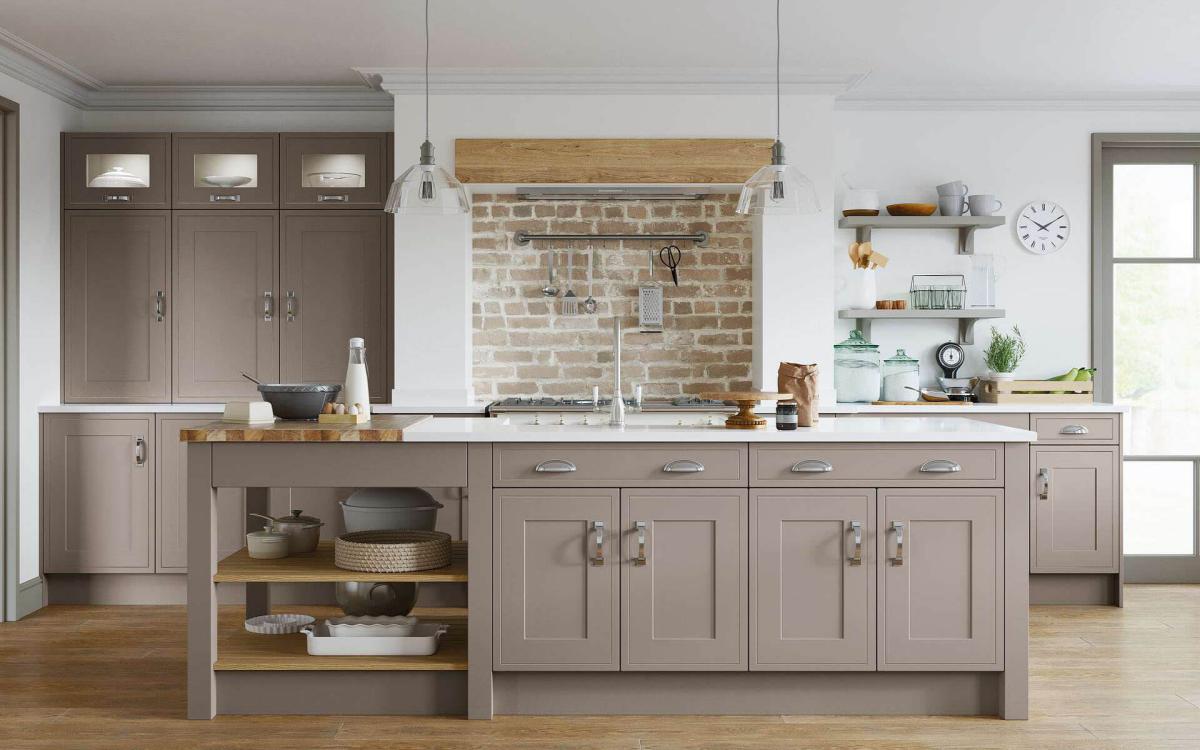
White Quartz worktop with Oak Pastry Bench Top
Matching Your Worktop to Your Culinary Needs
Ensuring that your worktop complements your culinary endeavours is paramount. But first, you must understand what type of cook you are.
Are you a dabbling dilettante, dipping your toes into the expansive universe of culinary greatness on lazy Sunday mornings, or are you the heart and pulsating soul of epic dinner parties with signature dishes that have family members and friends salivating at your doorstep?
Your cooking aspirations and daily kitchen practices should guide your decision-making.
Analyse your cooking regimen.
Do you frequently find yourself chopping, dicing, and julienning an assortment of vegetables, necessitating a hygienic non-porous surface like quartz or Corian®?
Or perhaps, you're partial to a good roll-up-your-sleeves baking session, in which case, you’ll require a cool, heat-absorbent material such as granite or marble. Accordingly, a keen eye should be cast on the key functional aspects that define your cooking routine.
Also, remember to factor in your cleaning tendencies.
If you loathe the idea of committing countless hours to maintenance, perhaps veer toward more practical, low-maintenance options such as laminate or stainless steel.
These worktops, while not as lustrous as their stone counterparts, can weather everyday kitchen incidents with relative ease and a damp cloth.
However, if you’re willing to invest time into maintaining the lustrous finish of your worktop, then materials such as granite, marble, or polished concrete may be fitting.
Remember, high-maintenance worktops offer a timeless appeal that we consider a worthwhile trade-off.
Besides preparing meals, consider what other purposes your kitchen serves.
If it’s the heart of your home where children do homework, where you drink your morning coffee while poring over the newspaper, or where you enjoy a glass of wine while preparing dinner, then it might be best to opt for a resilient material that can withstand more than just kitchen use.
In such cases, highly durable surfaces such as granite or quartz can serve you well.
We also recommend considering the visual qualities of your worktop material.
While robustness and functionality are critical, your worktop also contributes significantly to your kitchen's overall aesthetic appeal.
So, if you're drawn towards a modern minimalist appeal, then stainless steel or concrete might take pride of place in your kitchen.
Conversely, if a classic, warm ambience stirs your soul, then the natural stone aesthetic of granite or the marble's veined elegance could be your worktop soulmate.
Our parting advice to you, though, is to blend the practical with the aesthetic in your selection process, never compromising one for the other.
At the end of the day, your kitchen is the pulsating heart of your home, a space that should be as pragmatically delightful as it is visually stunning.
Durability and Maintenance Considerations
Without a doubt, durability and maintenance should be at the forefront of considerations when navigating the sea of worktop options for your kitchen.
It is a long-term investment, not simply a superficial fashion statement, and therefore the material chosen must fit the bill for your culinary preferences and its daily usage.
Beyond just aesthetics, you need a worktop that can take on high heat, splatters and spills, knife skills and heavy kitchen appliances.
The question you must ask yourself is, 'How often do you cook and what will be the daily wear and tear?'
Someone who merely heats up food in the microwave or makes sandwiches occasionally won't need the same resilience as an ardent cook who sees their kitchen as a bustling hub of activity, or a seasoned chef who needs a worktop that can stand up to brutal slicing and dicing, roasting and simmering, kneading and rolling.
To choose the right one, you must consider what will be part and parcel of your cooking style and frequency of use and weigh it against the durability rates and care needs of different worktop materials.
| Worktop Material | Durability Rate | Maintenance Needs |
|---|---|---|
| Laminate | Medium | Simple upkeep with standard cleaning, but vulnerable to heat and knife cuts. |
| Quartz | High | Resilient enough for minimal maintenance, resistant to heat, scratches, and stains. |
| Granite | High | Requires sealing for stain resistance. Can handle high heat and heavy use. |
| Stainless Steel | Very High | No maintenance required. Excellent resistance to heat and high use. Can scratch but adds to patina. |
| Wood | Medium-High | Various levels of care depending on finish. Most love the patina of use over time. |
Heat Resistance and Thermal Conductivity
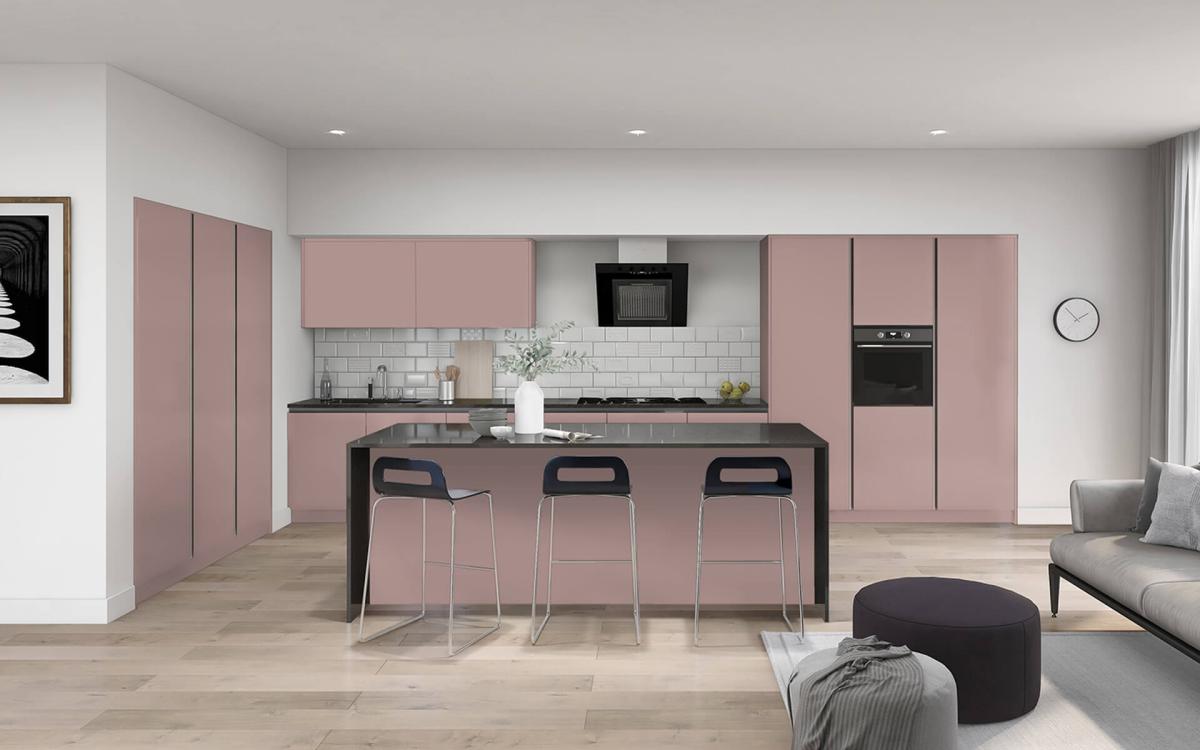
Black Quartz Worktops on Island Feature
When we dive into the intricacies of heat resistance and thermal conductivity, these aspects play a critical role in choosing kitchen worktop materials.
A perfect worktop should withstand high temperatures without losing its lustre or becoming marred by cracks or warps. To understand this better, let's unravel its ins and outs.
Understanding Heat Resistance
The term heat resistance in the context of kitchen worktops refers to the ability of the material to maintain its structural integrity and aesthetic appeal when subjected to high temperatures often from hot pots and pans.
It is paramount to choose a worktop material that can resist high heat if you tend to use your countertop as a potholder.
Implication of Thermal Conductivity
In simple terms, thermal conductivity refers to the property of a material to conduct heat.
If you are prone to placing hot vessels directly on your worktop, high thermal conductivity might be a problem as it could lead to burn spots or even warps in materials less resistant to heat.
And yet, low thermal conductivity may not be entirely advantageous either. Countertops with low thermal conductivity may keep surfaces too warm for too long if their exposure to heat is frequent.
Hence, an optimal balance is what you should be aiming for.
It's all about getting the right combination of heat resistance and thermal conductivity. The ideal worktop should resist high temperatures without losing its appeal while also ensuring heat is dispersed evenly and harmlessly.
Kitchen Worktop Materials and Their Heat Resistance
Now that you've comprehended these important factors, let's delve deeper into how different materials rank in terms of heat resistance and thermal conductivity.
| Material | Heat Resistance | Thermal Conductivity |
|---|---|---|
| Granite | High | Moderate |
| Marble | High | High |
| Quartz | Moderate | Low |
| Laminate | Low | Low |
| Wood | Low | High |
As seen in the table above, different materials have varying degrees of heat resistance and thermal conductivity.
Materials like granite and marble stand out for their high heat resistance, making them an excellent choice if you frequently place hot pots and pans directly on your work surface.
On the other hand, while laminate and wood might offer an appealing aesthetic, they fall short in terms of thermal properties, thereby imposing a requirement for careful handling of hot vessels.
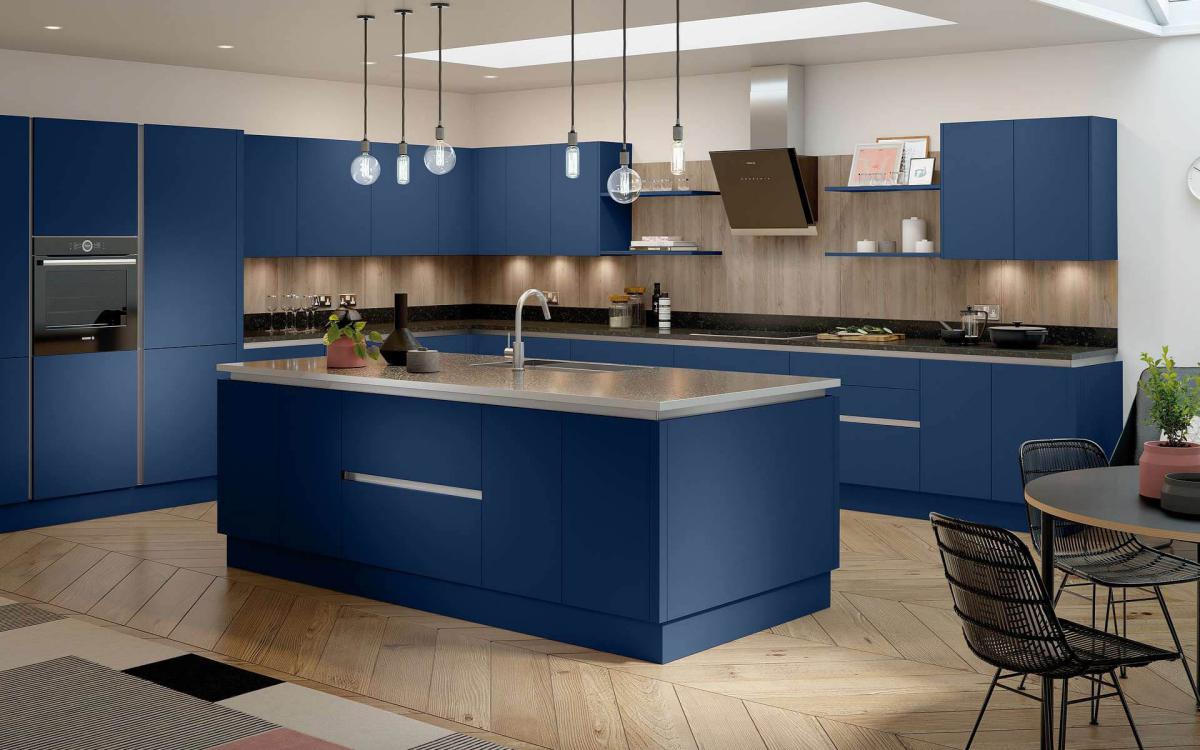
Steel Edged Laminate worktops create a striking feature on this Cassina Marine Blue Kitchen
Exploring the Benefits of Granite Worktops
If there's one thing we can unanimously agree upon, it's the indisputable fact that the choice of a kitchen countertop is not one to be taken lightly.
This choice, whilst seemingly superficial and cosmetic, can significantly influence your cooking style and general kitchen use. One material favoured by numerous cooking enthusiasts and space users is granite.
This highly recognised and admired choice invites you, potential kitchen renovators, to delve further into the benefits and potential drawbacks associated with it.
The Pros of Granite Worktops
- Durability: Granite is a tough and harsh-resistant material. Its compelling resistance to heat, scratches and stains makes it a perfect companion for the passionate and fervent cook who embraces a whirlwind of cooking activities.
- Lifespan: Granite maintains its allure over many years. Its ability to retain its radiance and elegance, even under the most strenuous of kitchen activities, is a testament to its longevity.
- Unique aesthetics: Each granite slab is incomparable to another. Its patterns, colours, veining, and intricate details transform your kitchen from just a cooking space to an alluring art display.
The Cons of Granite Worktops
- Price: Granite comes at a relatively steep cost. The features and benefits of granite, whilst outstanding, come with a price tag that may deter some potential users.
- Maintenance: Periodic sealing is necessary. Granite requires periodic sealing to maintain its resistant properties, which can be perceived as an added chore to some.
- Installation: Granite installation can be laborious. Given its cumbersome nature, we always recommend professional installation for granite worktops.
The seemingly minute details involved in the choice of a kitchen countertop can dramatically impact your overall cooking experience. Granite, with its unmatched resilience and undeniable beauty, has a way of elevating both casual and intensive cooking sessions.
Yet, it remains a commitment, a significant investment of both money and maintenance. The question that stands is, are the pros worth the cons for you?
Ultimately, your personal cooking style, budget, and maintenance preference should inform your countertop choice.
The Versatility of Quartz Worktops
If we cast our attention towards the eminent choice of quartz worktops, it becomes amply clear why they have gathered popularity among home owners and kitchen design aficionados. Versatile and elegant, these worktops pose more than just a pretty surface.
Advantages of Quartz Worktops
- Durability:
Quartz worktops are extraordinarily tough and durable. Capable of weathering high usage, they offer resistance against scratches and heat which can add years to their lifespan.
- Maintenance:
Unlike certain other worktop materials, quartz doesn’t require yearly sealing, making it a low-maintenance option. A simple routine of wiping with a mild detergent keeps it sanitary and shining.
- Versatility:
The range of colours, patterns, and finishes available with quartz allows it to blend effortlessly with any kitchen décor. From classic to contemporary, Quartz can style it all.
Disadvantages of Quartz Worktops
- Cost:
The quality and opulence of quartz worktops come at a price. While the initial investment might be more than other materials, its durability can make it cost-effective in the long run.
- Limited Heat Resistant:
Although Quartz is relatively heat-resistant, placing hot pans directly on the surface can discolour the material. Therefore, using trivets or heat pads is always recommended.
- Heavy:
Quartz worktops are incredibly heavy, requiring a strong cabinet base. This may limit their use in certain kitchen configurations or add to the expense of installation.
At the end of the day, the choice rests with you. Quartz offers beauty and durability, however, its limitations should be weighed against your specific kitchen needs and cooking style. As with any major decision, ample consideration and research can lead to kitchen contentment.
Budget-Friendly Worktop Options Without Compromising Quality
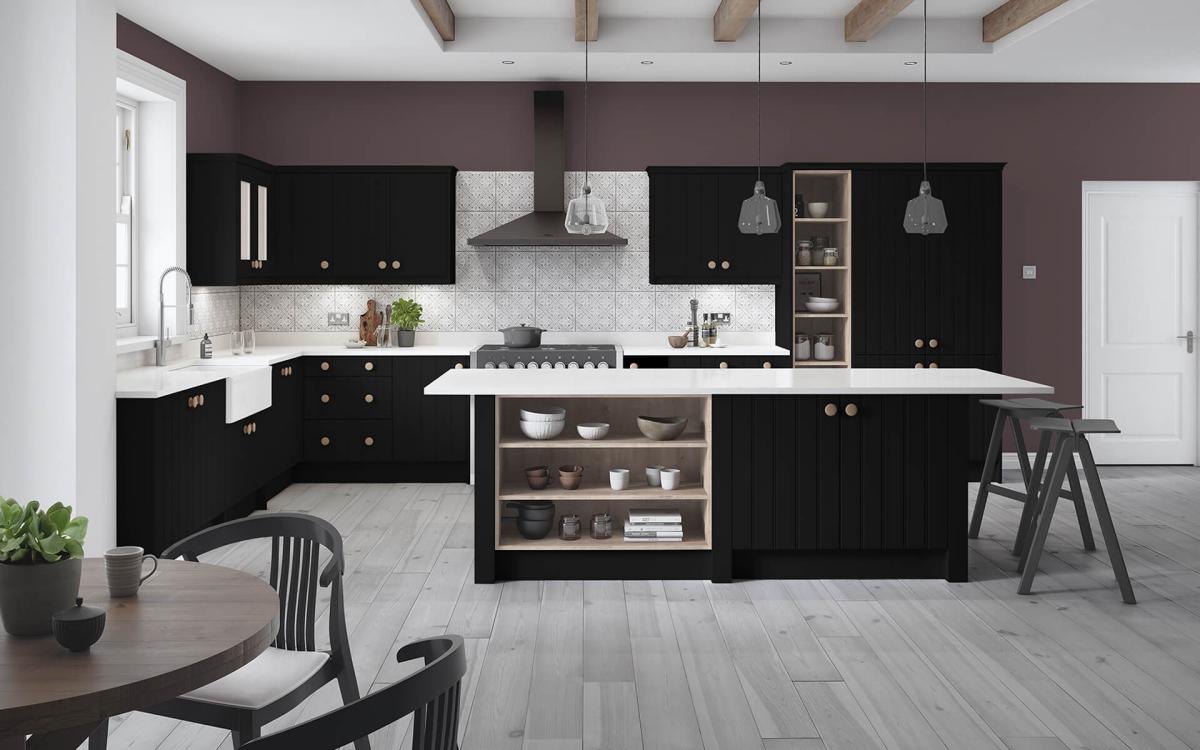
White worktops on the St Ives Black Vertical Grooved Kitchen
Although you may assume that premium quality and budget-friendly are disjointed when it comes to choosing kitchen worktops, there are indeed options that allow you to balance both without compromise.
Luxury does not always equate to efficiency, and several less expensive materials can admirably withstand the rigours of daily kitchen use.
Laminate Worktops
Consider the humble laminate worktop, often overlooked yet surprising in its resilience and range of designs. Boasting the joint advantages of affordability and low maintenance, laminate presents a highly serviceable and aesthetically pleasing choice.
Though it might not possess the heat resistance of more pricy options such as granite or quartz, it's an ideal choice if you're conscientious with hot items and place protective barriers between your worktop and hot pots.
Solid Wood Worktops
Let's not disregard solid wood worktops, which ooze traditional charm and warmth. Assuming you install diligent care routines, such as regular oiling, this material can last a lifetime.
With the added advantage of the inherent uniqueness of each piece, the tactile nature of wood also holds appeal.
Remember, it is susceptible to scratches and cuts, but they can be sanded out, lending wood a longevity that might surprise you.
Stainless Steel Worktops
Furthermore, we have stainless steel worktops, soaked in utilitarian chic and astronomical in their durability.
As the secret weapon of many a professional kitchen, its heat resistance and easy-cleaning regime are attractive features. Its resilience to moisture also makes it a worthy consideration when it comes to affordable workplace materials.
While it is prone to scratching and slight denting, a periodic polish is usually all it takes to restore its former glory.
As you can certainly glean, expensive does not automatically denote superiority.
By acknowledging your culinary habits and correlating them with the properties of your chosen material, you can save without sacrificing necessary functionality.
Non-Porous Surfaces: Ideal for Raw Food Preparation
If you often prepare raw foods, be it meats, fruits or vegetables, you'll recognise the importance of maintaining a clean and hygienic kitchen workspace.
A key attribute you must absolutely factor in when choosing your kitchen worktop is its porosity
Under the microscope, your worktop's surface can be far from smooth, with tiny bumps, nooks, and crannies that provide wonderful havens for bacteria and other potentially harmful microorganisms to thrive.
Amongst the myriad of materials available for worktops, non-porous materials such as Solid Surface Worktops stand out as your ideal option for these reasons.
Non-porous surfaces, as the name implies, are solid and do not absorb or permit the passage of liquids or gasses. This prime characteristic affords fundamental benefits crucial to sustainable, hygienic food preparation.
The Fundamental Hygienic Advantage
Non-porous materials, by virtue of their impermeable nature, repel water, stains, and bacteria. Raw foods, especially meats, are often associated with harmful bacteria such as salmonella and E.coli.
If you frequently chop raw vegetables, knead doughs, or marinate meats on your worktop, non-porous materials such as quartz, stainless steel or sealed granite offer an uninterruptible barrier against these bacteria.
They do not provide the crevices these microbes need to propagate.
Easy Cleanliness Ensures Safe Food Preparation
The ease of cleaning non-porous worktops further promotes sanitary workspaces. With a quick wipe using warm soapy water or a mild detergent, your worktop is clean and ready for the next culinary task.
Now, you might counter with the point that all worktops can be cleaned. However, it's the ease of cleanliness and the surety of a bacteria-free surface that sets non-porous materials apart.
Preserving Surface Integrity
Finally, the impermeability of non-porous materials preserves the aesthetic and functional integrity of your kitchen worktop.
They resist stains and discolouration's, ensuring your worktop retains its aesthetic appeal for substantial periods.
Furthermore, their resistance to water implies you don't have to worry about water damage or unseemly mould growth, both of which can compromise the lifespan and the visual appeal of porous worktops.
Invariably, if you are inclined towards preparing raw dishes, bearing in mind their inherent cleanliness and hygiene factors, the value of embracing non-porous kitchen worktops should not be understated.
Lean towards options like quartz, Corian, or sealed granite for your next kitchen redesign.
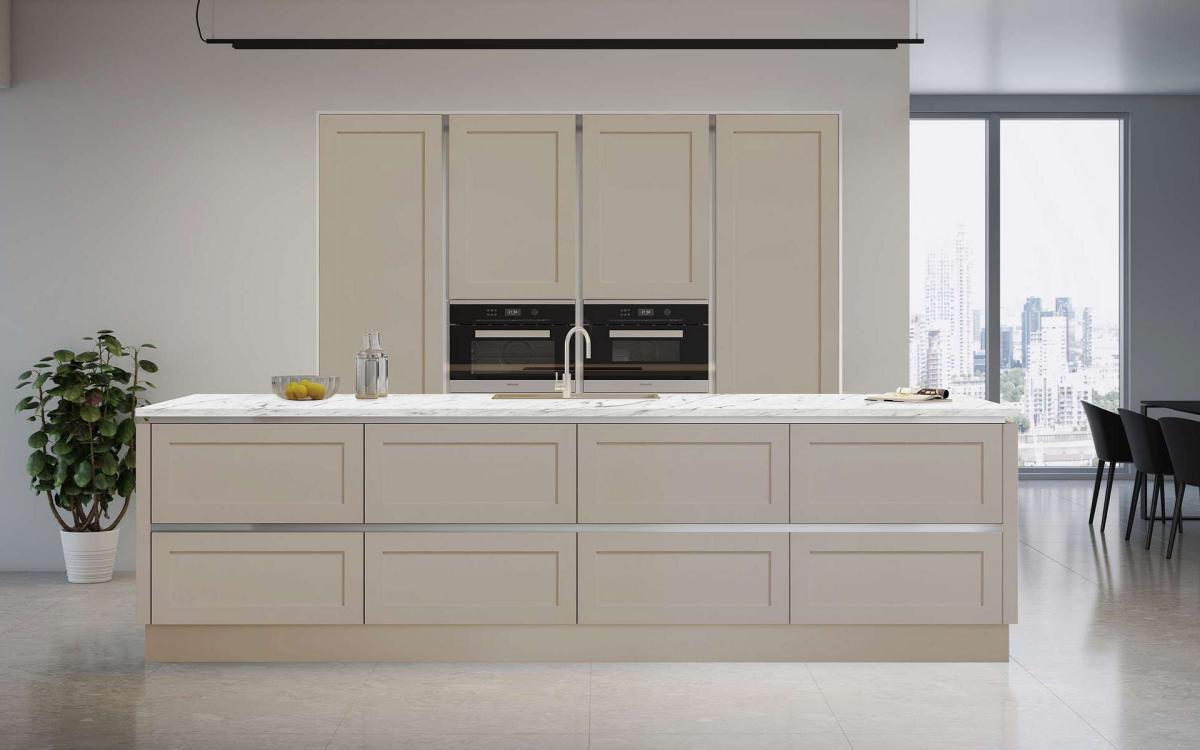
White Marbled Worktop on this Henley True Handless Shaker Kitchen
Choosing the Right Worktop for Baking Enthusiasts
As a baking aficionado, your focus should inherently gravitate towards the practicality and performance of the kitchen worktop surface.
The heat resistance, endurance, durability, ease of cleaning and maintenance are factors which play a pivotal role in our decision-making process. Let's take a hands-on approach, exploring each material meticulously in turn.
| Worktop Material | Advantages | Disadvantages |
|---|---|---|
| Marble | Stays cool; perfect for working with dough, confectionery and other temperature-sensitive baking tasks. | Prone to stains and scratches, requiring regular sealing. |
| Granite | Heat and scratch-resistant; durable and low maintenance. | Costly; requires professional installation; not suitable for DIY enthusiasts. |
| Wood | Creates a warm, traditional aesthetic; forgiving on pottery and glassware. | Requires regular maintenance; not ideal for handling hot items directly; |
| Stainless Steel | Hygienic; durable; heat and stain-resistant, reminiscent of professional kitchens. | Susceptible to scratches and dents; cold to touch. |
Indeed, if your kitchen is your blank canvas and the delicacies you churn out are your pieces of art, then certainly your worktop is your palette. A wisely chosen worktop can open up unprecedented opportunities, augmenting not only the aesthetic aspect but engaging you in your culinary ventures.
Making the Final Decision
Reaching an informed decision is paramount, and this should stem from a careful analysis considering all aspects – the pros and cons of each material, your personal preferences, the frequency of baking, your budget, and of course, the design and décor of your kitchen.
Hence, we present to you a compiled list of points that'll aid you in this crucial decision-making process:
- Scrutinise the cost-effectiveness: Reflect not limitedly to the upfront cost, but also the long-term implications like maintenance, durability, and the potential increase in your property value.
- Evaluate the Maintenance: Cleaning after a long baking session can be arduous. Worktop material and finish can make a significant difference to ease this task.
- Assess the Impact on Your Tools: Understand the effect each worktop might have on your bakery tools and ware. It's always advisable to go with ones that minimise wear and tear of your utensils.
- Gauge the Heat Resistance: Kitchens involve heat - ensure your chosen worktop can withstand temperatures without being susceptible to damage.
In the end, your individual cooking style, coupled with a deep understanding of the properties of your selected kitchen worktop, will guide you towards making an apt decision.
The right worktop can transform your kitchen into a haven of culinary exploration, offering you an inviting platform to hone and showcase your baking skills. We, at our end, wish you successful baking endeavours.
